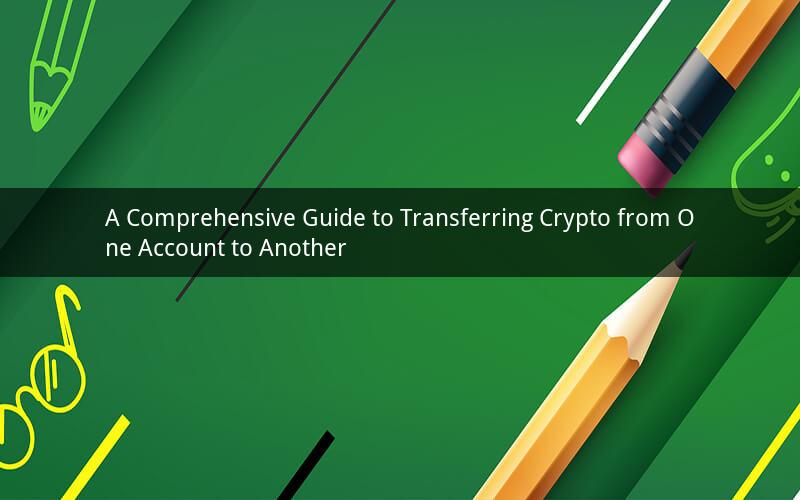
Transferring cryptocurrency from one account to another is a fundamental aspect of digital currency management. Whether you're a seasoned investor or a beginner exploring the world of blockchain, understanding how to move your digital assets is crucial. This article will delve into the process of transferring crypto, exploring different methods, security considerations, and frequently asked questions.
1. How to Transfer Crypto from One Account to Another
Transferring crypto from one account to another involves several steps, which may vary slightly depending on the platform you're using. Here's a general guide to help you navigate the process:
a. Choose the crypto you want to transfer: Before initiating a transfer, identify the cryptocurrency you wish to move from your current account to the destination account.
b. Select the platform: Decide whether you want to transfer the crypto through a centralized exchange, a decentralized exchange, or a wallet.
c. Access your account: Log in to your chosen platform and navigate to the transfer or withdrawal section.
d. Enter the recipient's address: Input the destination account's address, ensuring it's accurate to avoid losing your assets.
e. Enter the amount: Specify the amount of crypto you want to transfer. Keep in mind any potential network fees or transaction costs.
f. Confirm the transaction: Review the details of the transaction, including the recipient's address and the amount, before confirming the transfer.
g. Complete the transfer: Once you've confirmed the transaction, the crypto will be transferred from your account to the recipient's account.
2. Methods of Transferring Crypto
There are several methods to transfer crypto from one account to another, each with its unique advantages and disadvantages:
a. Centralized exchanges: These platforms act as intermediaries, allowing users to buy, sell, and transfer cryptocurrencies. They are user-friendly and offer various features, but centralized exchanges are subject to regulatory scrutiny and potential security risks.
b. Decentralized exchanges (DEXs): DEXs enable peer-to-peer transactions without intermediaries, offering increased privacy and security. However, they may have limited liquidity and a less intuitive user interface.
c. Wallets: Mobile and desktop wallets provide users with direct control over their cryptocurrencies. They can be used to transfer crypto to other wallets or exchanges. Wallets come in various types, including hot wallets (connected to the internet) and cold wallets (offline storage).
3. Security Considerations
Transferring crypto requires attention to security to prevent theft or loss of your assets. Here are some essential security practices:
a. Use a secure internet connection: Avoid transferring crypto over public Wi-Fi networks, as they can be vulnerable to hacking.
b. Verify the recipient's address: Double-check the destination address before initiating a transfer to avoid sending your assets to the wrong account.
c. Enable two-factor authentication (2FA): 2FA adds an extra layer of security by requiring a second form of verification, such as a text message or authenticator app, to access your account.
d. Keep your private keys secure: Private keys are essential for accessing your crypto assets. Store them in a secure location, such as a hardware wallet or a password-protected software wallet.
4. Common Questions and Answers
Q1: What is the difference between a wallet address and a public key?
A1: A wallet address is a unique identifier for your cryptocurrency account, while a public key is a longer string of characters used to verify transactions. Both are necessary for transferring crypto, but the wallet address is the one you'll need to share with others.
Q2: How long does it take to transfer crypto?
A2: The time it takes to transfer crypto can vary depending on the blockchain network, the amount of traffic on the network, and the chosen method. In general, transfers within the same network can take a few minutes to a few hours, while cross-chain transfers may take several hours or even days.
Q3: Can I cancel a crypto transfer?
A3: Once a crypto transfer has been initiated, it cannot be canceled. However, if the recipient has not yet accepted the transfer, you may be able to reverse the transaction by using a service like Bitcoin's "replace-by-fee" feature.
Q4: Are there any fees associated with transferring crypto?
A4: Yes, transferring crypto typically involves network fees, which are paid to the miners or validators who process the transaction. The fee amount can vary based on the blockchain network and the current traffic levels.
Q5: Can I transfer crypto to an exchange from a wallet?
A5: Yes, you can transfer crypto from a wallet to an exchange. Simply select the exchange as the destination address and follow the platform's instructions for transferring funds.
In conclusion, transferring crypto from one account to another is a fundamental skill for anyone involved in the digital currency space. By understanding the process, different methods, and security considerations, you can ensure a smooth and secure transfer of your digital assets. Always exercise caution and verify the recipient's address before initiating a transfer to avoid any potential issues.